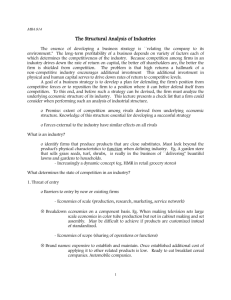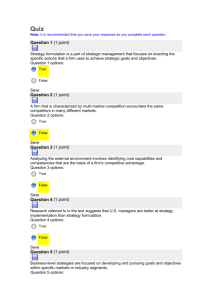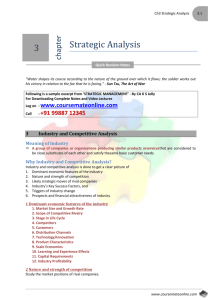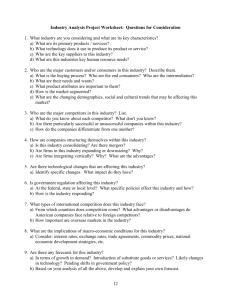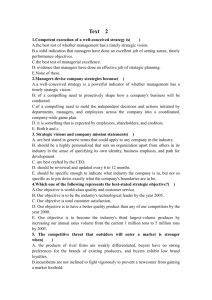File
advertisement
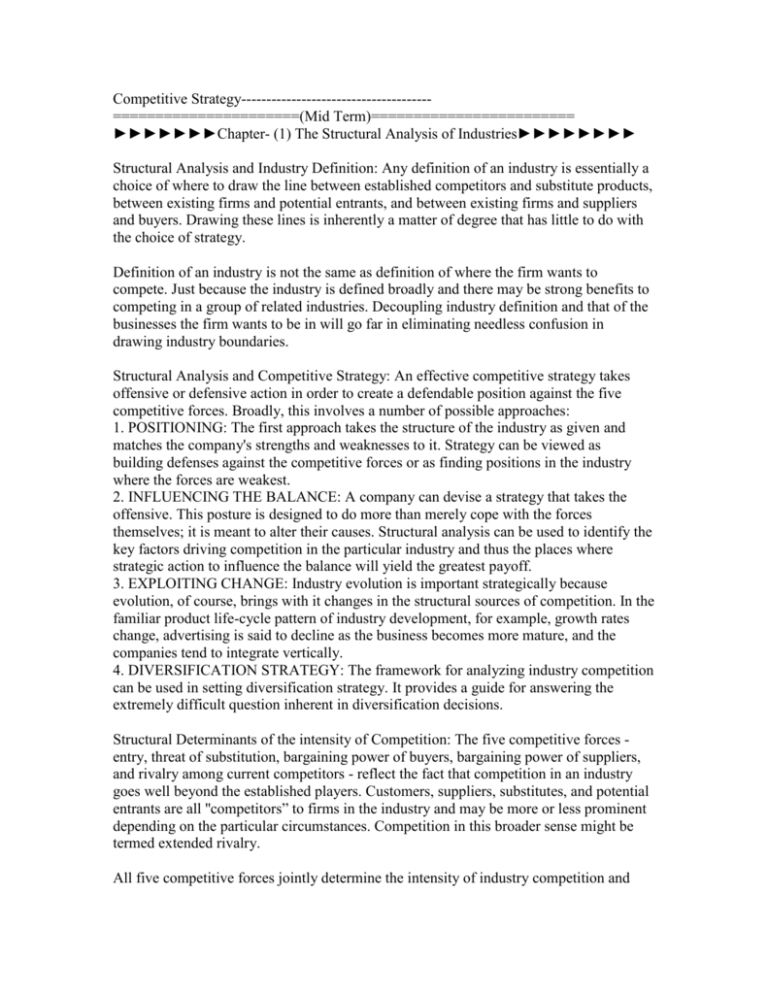
Competitive Strategy-------------------------------------======================(Mid Term)======================== ►►►►►►►Chapter- (1) The Structural Analysis of Industries►►►►►►►► Structural Analysis and Industry Definition: Any definition of an industry is essentially a choice of where to draw the line between established competitors and substitute products, between existing firms and potential entrants, and between existing firms and suppliers and buyers. Drawing these lines is inherently a matter of degree that has little to do with the choice of strategy. Definition of an industry is not the same as definition of where the firm wants to compete. Just because the industry is defined broadly and there may be strong benefits to competing in a group of related industries. Decoupling industry definition and that of the businesses the firm wants to be in will go far in eliminating needless confusion in drawing industry boundaries. Structural Analysis and Competitive Strategy: An effective competitive strategy takes offensive or defensive action in order to create a defendable position against the five competitive forces. Broadly, this involves a number of possible approaches: 1. POSITIONING: The first approach takes the structure of the industry as given and matches the company's strengths and weaknesses to it. Strategy can be viewed as building defenses against the competitive forces or as finding positions in the industry where the forces are weakest. 2. INFLUENCING THE BALANCE: A company can devise a strategy that takes the offensive. This posture is designed to do more than merely cope with the forces themselves; it is meant to alter their causes. Structural analysis can be used to identify the key factors driving competition in the particular industry and thus the places where strategic action to influence the balance will yield the greatest payoff. 3. EXPLOITING CHANGE: Industry evolution is important strategically because evolution, of course, brings with it changes in the structural sources of competition. In the familiar product life-cycle pattern of industry development, for example, growth rates change, advertising is said to decline as the business becomes more mature, and the companies tend to integrate vertically. 4. DIVERSIFICATION STRATEGY: The framework for analyzing industry competition can be used in setting diversification strategy. It provides a guide for answering the extremely difficult question inherent in diversification decisions. Structural Determinants of the intensity of Competition: The five competitive forces entry, threat of substitution, bargaining power of buyers, bargaining power of suppliers, and rivalry among current competitors - reflect the fact that competition in an industry goes well beyond the established players. Customers, suppliers, substitutes, and potential entrants are all ''competitors” to firms in the industry and may be more or less prominent depending on the particular circumstances. Competition in this broader sense might be termed extended rivalry. All five competitive forces jointly determine the intensity of industry competition and profitability, and the strongest force or forces are governing and become crucial from the point of view of strategy formulation. strength of the forces should be distinguished from the many short- run factors that can affect competition and profitability in a transient way. Firms will each have unique strengths and weaknesses in dealing with industry structure and industry structure can and does shift gradually over time. Yet understanding industry structure must be the starting point for strategic analysis. A number of important economic and technical characteristics of an industry are critical to the strength of each competitive force. These are discussed in below: 1. Threat of Entry: New entrants to an industry bring new capacity, the desire to gain market share, and often substantial resources. The threat of entry into an industry depends on the barriers to entry that are present, coupled with the reaction from existing competitors that the entrant can expect. If barriers are high and/or the newcomer can expect sharp retaliation from entrenched competitors, the threat of entry is low. 2. Barriers Entry: There are six major sources of barriers to entry: • Economies of Scale: Economies of scale refer to declines in unit costs of a product (or operation or function that goes into producing a product) as the absolute volume per period increases. Economies of scale deter entry by forcing the entrant to come in at large scale and risk strong reaction from existing firms or come in at a small scale and accept a cost disadvantage, both undesirable options. Scale economies can be present in nearly every function of a business, including manufacturing, purchasing, research and development, marketing, service network, sales force utilization, and distribution. A type of economies of scale entry barrier occurs when there are economies to vertical integration that is operating in successive stages of production or distribution. Here the entrant must enter integrated or face a cost disadvantage, as well as possible foreclosure of inputs or markets for its product if most established competitors are integrated. • Product Differentiation: Product differentiation means that established firms have brand identification and customer loyalties, which stem from past advertising, customer service, product differences, or simply being first into the industry. Differentiation creates a barrier to entry by forcing entrants to spend heavily to overcome existing customer loyalties. This effort usually involves start-up losses and often takes an extended period of time. Product differentiation is perhaps the most important entry barrier in baby care products, over-the-counter drugs, cosmetics, investment banking, and public accounting. • Capital Requirements: The need to invest large financial resources in order to compete creates a barrier to entry, particularly if the capital is required for risky or unrecoverable up-front advertising or research and development (R&D). Capital may be necessary not only for production facilities but also for things like customer credit, inventories, or covering start-up losses. • Switching Costs: A barrier to entry is created by the presence of switching costs, that is, one-time costs facing the buyer of switching from one supplier's product to another's. Switching costs may include employee retraining costs, cost of new ancillary equipment, cost and time in testing or qualifying a new source, need for technical help as a result of reliance on seller engineering aid, product redesign, or even psychic costs of severing a relationship. If these switching costs are high, then new entrants must offer a major improvement in cost or performance in order for the buyer to switch from an incumbent. • Access to Distribution Channels: A barrier to entry can be created by the new entrant's need to secure distribution for its product. To the extent that logical distribution channels for the product have already been served by established firms, the new firm must persuade the channels to accept its product through price breaks, cooperative advertising allowances, and the like, which reduce profits. • Government Policy: The last major source of entry barriers is government policy. Government can limit or even foreclose entry into industries with such controls as licensing requirements and limits on access to raw materials. Regulated industries like trucking, railroads, liquor retailing, and freight forwarding are obvious examples. Government policy in such areas certainly has direct social benefits, but it often has secondary consequences for entry which are unrecognized. 3. Cost Disadvantages Independent of Scale: Established firms may have cost advantages not replicable by potential entrants no matter what their size and attained economies of scale. The most critical advantages are factors such as the following: • Proprietary product technology: product know-how or design characteristics that are kept proprietary through patents or secrecy. • Favorable access to raw materials: established firms may have locked up the most favorable sources and/or tied up foreseeable needs early at prices reflecting a lower demand for them than currently exists. • Favorable locations: established firms may have cornered favorable locations before market forces bid up prices to capture their full value. • Government subsidies: preferential government subsidies may give established firms lasting advantages in some businesses. • Learning or experience curve: in some businesses, there is an observed tendency for unit costs to decline as the firm gains more cumulative experience in producing a product. 4. Expected Retaliation: The potential entrant's expectations about the reaction of existing competitors also will influence the threat of entry. If existing competitors are expected to respond forcefully to make the entrant's stay in the industry an unpleasant one, then entry may well be deterred. Conditions that signal the strong likelihood of retaliation to entry and hence deter it are the following: • established firms with substantial resources to fight back, including excess cash and unused borrowing capacity, adequate excess productive capacity to meet all likely future needs, or great leverage with distribution channels or customers. • established firms with great commitment to the industry and highly illiquid assets employed in it; • slow industry growth, which limits the ability of the industry to absorb a new firm without depressing the sales and financial performance of established firms. 5. The Entry Deterring Price: The condition of entry in an industry can be summarized in an important hypothetical concept called the entry deterring price: the prevailing structure of prices which just balances the potential rewards from entry (forecast by the potential entrant) with the expected costs of overcoming structural entry barriers and risking retaliation. If the current price level is higher than the entry deterring price, entrants will forecast above-average profits from entry, and entry will occur. Of course the entry deterring price depends on entrants' expectations of the future and not just current conditions. The threat of entry into an industry can be eliminated if incumbent firms choose or are forced by competition to price below this hypothetical entry deterring price. 6. Properties or Entry Barriers: There are several additional properties of entry barriers that are crucial from a strategic standpoint. First, entry barriers can and do change as the conditions previously described change. The expire of Polaroid's basic patents on instant photography, for instance, greatly reduced its absolute cost entry barrier built by proprietary technology. Second, although entry barriers sometimes change for reasons largely outside the firm's control, the firth's strategic decisions also can have a major impact. Finally, some firms may possess resources or skills which allow them to overcome entry barrier into an industry more cheaply than most other firms. 7. Experience and Scale as Entry Barriers: The presence of economies of scale always leads to a cost advantage for the large- scale firm over small-scale firms, presupposing that the former have the most efficient facilities, distribution systems, service organizations, or other functional activities for their size. Some limits to economies of scale as an entry barrier, from the strategic standpoint of incumbents, are as follows: • Large-scale and hence lower costs may involve trade-offs with other potentially valuable barriers to entry such as product differentiation or the ability to develop proprietary technology rapidly. • Technological change may penalize the large-scale firm if facilities designed to reap scale economies are also more specialized and less flexible in adapting to new technologies. • Commitment to achieving scale economies by using existing technology may cloud the perception of new technological possibilities or of other new ways of competing that are less dependent on scale. Other limits to the experience curve as an entry barrier are as follows: • The barrier can be nullified by product or process innovations leading to a substantially new technology and thereby creating an entirely new experience curve. • Pursuit of low cost through experience may involve tradeoffs with other valuable barriers, such as product differentiation through image or technological progressiveness. • If more than one strong company is building its strategy on the experience curve, the consequences for one or more of them can be nearly fatal. • Aggressive pursuit of cost declines through experience may draw attention away from market developments in other areas or may cloud perception of new technologies that nullify past experience. INTENSITY OF RIVALRY AMONG EXISTING COMPETITORS: Rivalry among existing competitors takes the familiar form of jockeying for position - using tactics like price competition, advertising battles, product introductions, and increased customer service or warranties. Rivalry occurs because one or more competitors either feels the pressure or sees the opportunity to improve position. In most industries, competitive moves by one firm have noticeable effects on its competitors and thus may incite retaliation or efforts to counter the move; that is, firms are mutually dependent. This pattern of action and reaction may or may not leave the initiating firm and the industry as a whole better off. If moves and countermoves escalate, then all firms in the industry may suffer and be worse off than before. In many industries foreign competitors, either exporting into the industry or participating directly through foreign investment, play an important role in industry competition. Foreign competitors, although having some differences that will be noted later, should be treated just like national competitors for purposes of structural analysis. 1. Slow Industry Growth: Slow industry growth turns competition into a market share game for firms seeking expansion. Market share competition is a great deal more volatile than is the situation in which rapid industry growth insures that firms can improve results just by keeping up with the industry, and where all their financial and managerial resources may be consumed by expanding with the industry. 2. High Fixed or Storage Costs: High fixed costs create strong pressures for all firms to fill capacity which often lead to rapidly escalating price cutting when excess capacity is present. A situation related to high fixed costs is one in which the product, once produced, is very difficult or costly to store. 3. Lack of Differentiation or Switching Costs: Where the product or service is perceived as a commodity or near commodity, choice by the buyer is largely based on price and service, and pressures for intense price and service competition result. These forms of competition are particularly volatile, as has been discussed. Product differentiation, on the other hand, creates layers of insulation against competitive warfare because buyers have preferences and loyalties to particular sellers. 4. Diverse Competitors: Competitors diverse in strategies, origins, personalities, and relationships to their parent companies have differing goals and differing strategies for how to compete and may continually run head on into each other in the process. 5. High Strategic Stakes: Rivalry in an industry becomes even more volatile if a number of firms have high stakes in achieving success there. 6. High Exit Barriers: Exit barriers are economic, strategic, and emotional factors that keep companies competing in businesses even though they may be earning low or even negative returns on investment. The major sources of exit barriers are the following: • Specialized assets: assets highly specialized to the particular business or location has low liquidation values or high costs of transfer or conversion • Fixed costs of exit: these include labor agreements, resettlement costs, maintaining capabilities for spare parts, and so on. • Strategic interrelationships: interrelationships between the business unit and others in the company in terms of image, marketing ability, access to financial markets, shared facilities, and so on. • Emotional barriers: management's unwillingness to make economically justified exit decisions is caused by identification with the particular business, loyalty to employees, fear for one's own career, pride, and other reasons. • Government and social restrictions: these involve government denial or discouragement of exit out of concern for job loss and regional economic effects; they are particularly common outside the United States. SHIFTING RIVALRY: The factors that determine the intensity of competitive rivalry can and do change. A very common example is the change in industry growth brought about by industry maturity. As an industry matures its growth rate declines, resulting in intensified rivalry, declining profits, and (often) a shake-out. Although a company must live with many of the factors that determine the intensity of industry rivalry - because they are built into industry economics - it may have some latitude in improving matters through strategic shifts. EXIT BARRIERS AND ENTRY BARRIERS: Although exit barriers and entry barriers are conceptually different, their joint level is an important aspect of the analysis of an industry. Often exit and entry barriers are related. Substantial economies of scale in production, for example, are usually associated with specialized assets, as is the presence of proprietary technology. Taking the simplified case in which exit and entry barriers can be either high or low: Exit Barriers Low High Low, Stable Entry Low, Risky Returns High, Stable Returns High, Risky Returns Low Entry Barriers High The best case from the viewpoint of industry profits is one in which entry barriers are high but exit barriers are low. Here entry will be deterred, and unsuccessful competitors will leave the industry. When both entry and exit barriers are high, profit potential is high but is usually accompanied by more risk. Although entry is deterred, unsuccessful firms will stay and fight in the industry. The case of low entry and exit barriers is merely unexciting, but the worst case is one in which entry barriers are low and exit barriers are high. Here entry is easy and will be attracted by upturns in economic conditions or other temporary windfalls. However, capacity will not leave the industry when results deteriorate. PRESSURE FROM SUBSTITUTE PRODUCTS: All firms in an industry are competing, in a broad sense, with industries producing substitute products. Substitutes limit the potential returns of an industry by placing a ceiling on the prices firms in the industry can profitably charge. The more attractive the price- performance alternative offered by substitutes, the firmer the lid on industry profits. Identifying substitute products is a matter of searching for other products that can perform the same function as the product of the industry. Sometimes doing so can be a subtle task, and one which leads the analyst into businesses seemingly far removed from the industry. Substitute products that deserve the most attention are those that are subject to trends improving their price-performance tradeoff with the industry's product, or are produced by industries earning high profits. BARGAINING POWER OF BUYERS: Buyers compete with the industry by forcing down prices, bargaining for higher quality or more services, and playing competitors against each other - all at the expense of industry profitability. The power of each of the industry's important buyer groups depends on a number of characteristics of its market situation and on the relative importance of its purchases from the industry compared with its overall business. A buyer group is powerful if the following circumstances hold true: • It is concentrated or purchases large volumes relative to seller sales. If a large portion of sales is purchased by a given buyer this raises the importance of the buyer's business in results. • The products it purchases from the industry represent a significant fraction of the buyer's costs or purchases. Here buyers are prone to expend the resources necessary to shop for a favorable price and purchase selectively. • The products it purchases from the industry are standard or undifferentiated. Buyers, sure that they can always find alternative suppliers, may play one company against another, as they do in aluminum extrusion. ALTERING BUYER POWER: A company's choice of buyer groups to sell to should be viewed as a crucial strategic decision. A company can improve its strategic posture by finding buyers who possess the least power to influence it adversely - in other words, buyer selection. Rarely do all the buyer groups a company sell to enjoy equal power. Even if a company sells to a single industry, segments usually exist within that industry which exercises less power than others. BARGAINING POWER OF SUPPLIERS: Suppliers can exert bargaining power over participants in an industry by threatening to raise prices or reduce the quality of purchased goods and services. Powerful suppliers can thereby squeeze profitability out of an industry unable to recover cost increases in its own prices. By raising their prices, for example, chemical companies have contributed to the erosion of profitability of contract aerosol packagers because the packagers, facing intense competition from selfmanufacture by their buyers, accordingly have limited freedom to raise their prices. It is dominated by a few companies and is more concentrated than the industry it sells to. Suppliers selling to more fragmented buyers will usually be able to exert considerable influence in prices, quality, and terms. GOVERNMENT AS A FORCE IN INDUSTRY COMPETITION: In many industries, government is a buyer or supplier and can influence industry competition by the policies it adopts. Many times government's role as a supplier or buyer is determined more by political factors than by economic circumstances, and this is probably a fact of life. Government regulations can also set limits on the behavior of firms as suppliers or buyers. Government can also affect the position of an industry with substitutes through regulations, subsidies, or other means. Government decontrol of natural gas is quickly eliminating acetylene as a chemical feedstock. Safety and pollution standards affect relative cost and quality of substitutes. Government can also affect rivalry among competitors by influencing industry growth, the cost structure through regulations, and so on. Thus no structural analysis is complete without a diagnosis of how present and future government policy, at all levels, will affect structural conditions. For purposes of strategic analysis it is usually more illuminating to consider how government affects competition through the five competitive forces than to consider it as a force in and of itself. However, strategy may well involve treating government as an actor to be influenced.
